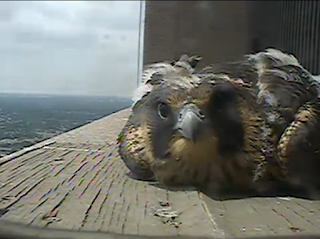Transitioning to Flight
Peregrines begin flying at about 40 days of age. The actual time to fledge can be more or less depending on the circumstances and/or an individual bird's development (males develop faster than females and typically fledge earlier than female nest mates). At any rate, we are approaching the time in the nesting cycle that the young peregrines will soon transition from nestlings to fledglings.
All of the young are the same size as the adults at this point. The main difference is they may actually weigh a little more, having just been "ledge potatoes" up until this point, eating and growing and eating more (vs. the adults that are active and spending most of their time hunting for the chicks as well as themselves). Their plumage is also different from the adults--the chicks have the trademark brown juvenile feathering that includes brown/creamy vertical streaking on their chest. Adults have the blue/gray backs, a light breast and horizontal streaking on their chest.
The main "job" of a pre-fledgling falcon is to practice flapping, running and getting lift. Here is a video of some exercising activity on the ledge. Note in the video that one of the young falcons starts off on top of the nest box. Hopefully, they will take their time and spend the next several days practicing and building up their flight muscles before actually leaving the ledge. The ideal first flight is a calculated exit from the ledge but it can happen that a young falcon is knocked off the ledge (or falls off) in a wind gust, from simple loss of balance when standing too near to the edge or in a tussle over food with a nest mate. We've seen all of these scenarios happen over the years at this site.
Regardless of the reason of leaving the ledge, all of the falcons have the "equipment" they need to fly and flapping is pure instinct. What is the hardest part with the initial flights is getting the hang of how to use the equipment they have--how to steer, how to glide, how to lose or gain speed and altitude and otherwise maneuver. It can be a sharp learning curve regarding landing - honing the above skills as well as figuring out what surfaces are good and easy to land on vs. not. And don't forget all of the glass downtown that reflects sky that can be extremely confusing to a young, inexperienced peregrine. City environments do present unique dangers that a wilderness cliff nest may not, but the urban habitats also have their perks in the way of abundant food, warmth and people on the ground watching out for them should they happen to end up on the ground.
Downtown workers and viewers are encouraged to send in photos (Wildinfo@dnr.state.oh.us) documenting fledging. We will post updates here as we become aware of happenings!
All of the young are the same size as the adults at this point. The main difference is they may actually weigh a little more, having just been "ledge potatoes" up until this point, eating and growing and eating more (vs. the adults that are active and spending most of their time hunting for the chicks as well as themselves). Their plumage is also different from the adults--the chicks have the trademark brown juvenile feathering that includes brown/creamy vertical streaking on their chest. Adults have the blue/gray backs, a light breast and horizontal streaking on their chest.
The main "job" of a pre-fledgling falcon is to practice flapping, running and getting lift. Here is a video of some exercising activity on the ledge. Note in the video that one of the young falcons starts off on top of the nest box. Hopefully, they will take their time and spend the next several days practicing and building up their flight muscles before actually leaving the ledge. The ideal first flight is a calculated exit from the ledge but it can happen that a young falcon is knocked off the ledge (or falls off) in a wind gust, from simple loss of balance when standing too near to the edge or in a tussle over food with a nest mate. We've seen all of these scenarios happen over the years at this site.
Regardless of the reason of leaving the ledge, all of the falcons have the "equipment" they need to fly and flapping is pure instinct. What is the hardest part with the initial flights is getting the hang of how to use the equipment they have--how to steer, how to glide, how to lose or gain speed and altitude and otherwise maneuver. It can be a sharp learning curve regarding landing - honing the above skills as well as figuring out what surfaces are good and easy to land on vs. not. And don't forget all of the glass downtown that reflects sky that can be extremely confusing to a young, inexperienced peregrine. City environments do present unique dangers that a wilderness cliff nest may not, but the urban habitats also have their perks in the way of abundant food, warmth and people on the ground watching out for them should they happen to end up on the ground.
Downtown workers and viewers are encouraged to send in photos (Wildinfo@dnr.state.oh.us) documenting fledging. We will post updates here as we become aware of happenings!




<< Home